Revista Europea de Derecho de la Navegación Marítima y Aeronáutica
ISSN versión electrónica: 2386-8902
ISSN versión impresa: 1130-2127
Depósito Legal: Z-3235-99
SORA - ASSUMPTIONS AND EVALUATION OF THE METHOD
Wiktor WYSZYWACZ
ABSTRACT: The SORA (Specific Operations Risk Assessment) method is a risk management model for flights performed by unmanned aerial vehicles and meets the requirements of the Commission Implementing Regulation (EU) 2019/947. The concept of the method was presented and the general course of the SORA process was presented. Annexes A, B, C, D and E are indicated which contain details of the individual steps of the procedure. The method has advantages, but also disadvantages and limitations. An analysis of the features and functionality of the SORA method was carried out, which allowed for the formulation of the method utility assessment.
KEY WORDS: SORA, UAS, Risk analysis, Risk management
STRESZCZENIE:Metoda SORA (Specific Operations Risk Assessment) jest modelem zarządzania ryzykiem w lotach wykonywanych przez bezzałogowe statki powietrzne i spełnia wymagania zawarte w rozporządzeniu wykonawczym Komisji (UE) 2019/947. Zaprezentowano koncepcję metody i przedstawiono ogólny przebieg procesu SORA. Wskazano załączniki A, B, C, D i E w których znajdują się szczegóły dotyczące poszczególnych kroków procedury. Metoda ma zalety, ale również wady i ograniczenia. Przeprowadzono analizę cech i funkcjonalności metody SORA, co pozwoliło na sformułowanie oceny użyteczności metody.
SŁOWA KLUCZOWE:SORA, SBSP, Analiza ryzyka, Zarządzanie ryzykiem
Acronyms and abbreviations
AMC - Acceptable Means of Compliance and GM (Guidance Material);
AGL - Above Ground Level;
ARC - Air Class Risk;
ATC - Air Traffic Control;
BVLOS - Beyond Visual Line of Sight Operation;
CAA - Civil Aviation Authority;
CBZ - Central Reports Database;
CONOPS - Concept of Operations;
DAA - Detect And Avoid;
EASA - European Union Aviation Safety Agency;
ERP - Emergency Response Plan;
EUROCONTROL - is a pan-European, civil-military organisation dedicated to supporting European aviation;
FAA - Federal Aviation Administration;
FLARM – (portmanteau of "flight" and "alarm") - an electronic system used to selectively warn pilots of potential collisions between light aircraft;
GRC - Ground Risk Class;
HMI – Human Machine Interface;
ICAO - International Civil Aviation Organization;
JARUS - Joint Authorities for Rulemaking on Unmanned Systems;
KGP - Police Headquarters in Poland;
LUC - Light UAS Operator Certificate;
NAA - National Aviation Authority;
OSO - Operational Safety Objectives;
PansaUTM - PANSA - Polish Air Navigation Services Agency, UTM - Unmanned Traffic Management;
SAIL - Specific Assurance and Integrity Levels;
SHELL - (software, hardware, liveware, environment) an acronym for a model that emphasizes the relationship between humans and the environment of the aviation system;
SORA - Specific Operations Risk Assessment;
STS - Standard Scenario;
TLS - Target Level of Safety;
TMPR - Tactical Mitigation Performance Requirement and Robustness Levels;
UAS - Unmanned Aerial Systems;
UAVO - Unmanned Aerial Vehicle Operator;
ULC - Civil Aviation Authority;
U-space -a set of new facilities based on high-level functions and procedures, designed to support the safety, efficiency, and safe access to airspace for a large number of UAVs, prepared by the SESAR JU organization;
VLOS - Visual Line of Sight Operation.
1. Introduction.
The JARUS organization (Joint Authorities for Rulemaking on Unmanned Systems) brings together world experts from 61 countries, EASA and EUROCONTROL, representatives of national aviation authorities, industry, and airlines. The document submitted by the JARUS organization under the name "SORA v2.0" (Specific Operations Risk Assessment) [11] presents the UAS operations risk management model to be used by operators and aviation authorities.
The methodology presented in this document is intended to assess the risks associated with the operation of unmanned aerial vehicle systems (UAS) of any class and size and type of operation (including military, experimental, research and development, and prototype). Suitable, but not limited to, the categories of specific operations for which a hazard and risk assessment is required. The specific objective of the SORA is to propose a risk assessment methodology to support an NAA application for authorization to conduct UAS operations and obtain approval for specific category flights in accordance with EU Commission Implementing Regulation 2019/947 [4]. The SORA is also a tool for the competent aviation authority to help determine whether the operation can be conducted safely and what measures should be taken to reduce the risk to an acceptable level. SORA does not contain normative requirements, but safety objectives that have to be met with different levels of reliability commensurate with the risk. The SORA is intended to replace risk management methods used in manned aviation, which cannot be directly and effectively applied to unmanned aerial vehicles.
The safety of unmanned aerial vehicle operations is important to all stakeholders of manned aviation, including governments. The level of UAS flight safety must not differ significantly from that of manned aviation. For over one hundred years a high level of confidence in air transport has been developed. The assumptions and comparison of the safety level of UAS flights with manned aviation are presented in Figures 1 and 2 [13].
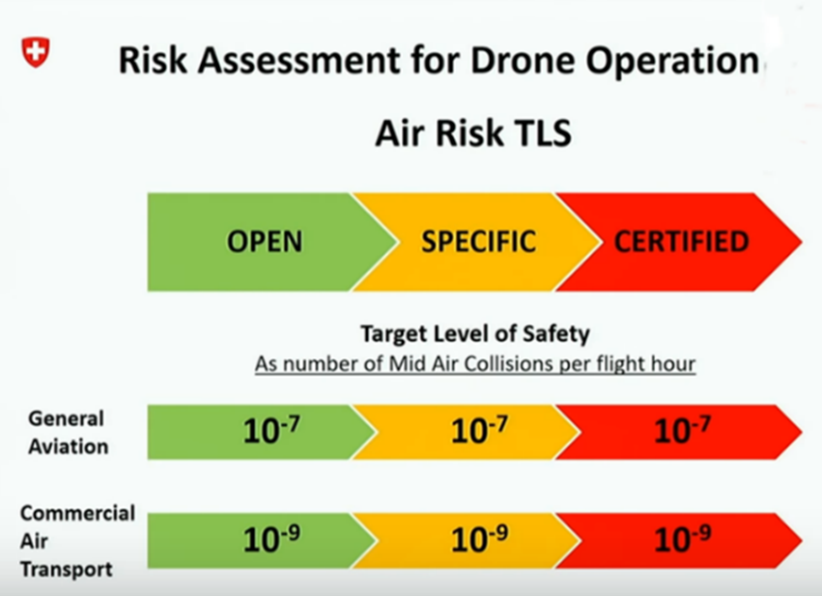
Fig. 1. Comparison of TLS for airborne risk
Source: Methodology for the Specific Ops Risk Assessment (SORA) by JARUS - UAS Workshop 2018
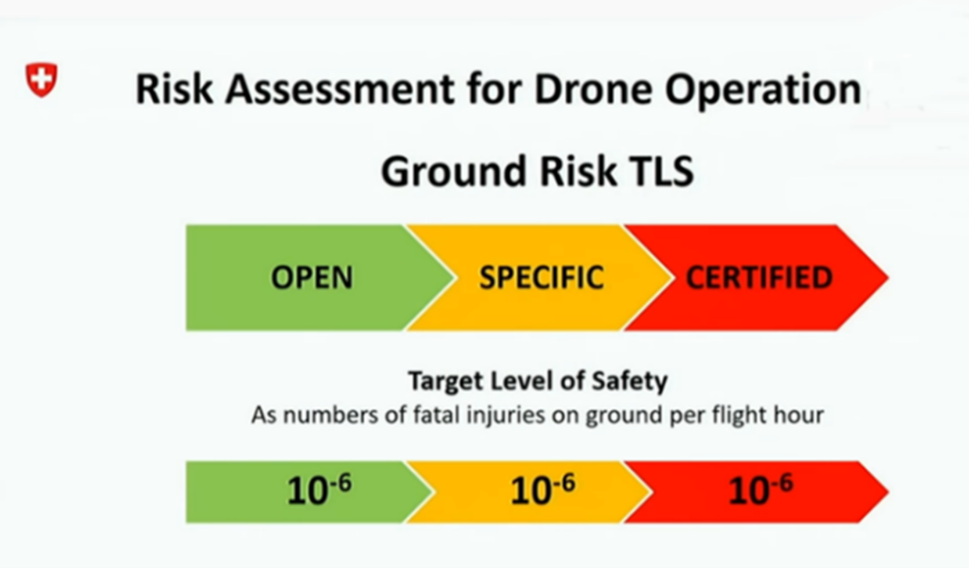
Fig. 1. Fig. 2 Comparison of TLS for risk on the ground
Source: Methodology for the Specific Ops Risk Assessment (SORA) by JARUS - UAS Workshop 2018
Currently and in the next decade, the unmanned aerial vehicle industry will develop dynamically. UAS used in the economy, services, science, or activities of services are now an invaluable source of information obtained from specialized sensors installed on their board. These systems are also used to transport cargo and goods. The following facts prove the rapid development of the industry and safety aspects:
UAVO qualification certificates ~ 20,000
• 112 training entities;
• Estimated number of drones in Poland - over 100,000;
• Number of incidents from CBZ [2] for 2019 – 70;
• KGP in 2018 and 2019 confirmed 691 and 719 incidents involving UAS, respectively
• Pansa UTM [14] (until November 2020) about 250,000 check-ins of operations for UAS.
UAS flight safety issues are currently one of the most important challenges for the sustainable development of the UAS industry. In manned aviation, as opposed to unmanned aircraft, there are many theories and models of safety systems. The most important models are:
• 5M - it is used to solve problems and risk management in aviation, showing the interaction, human, management, devices, and the environment in the implementation of the mission [1,15];
• SHELL (software, hardware, liveware, environment) - is an acronym that defines a model that emphasizes human relations with the environment of the aviation system [7, 15];
• Reason ("Swiss cheese") - presents the components and mechanism of accidents. The elements of the safety system are protective barriers to prevent accidents. Each of them has imperfect spots that are compared to holes in a slice of Swiss cheese [8].
Elements of the theory and models of safety and regulations used for manned aviation can be used for UAS flights. However, the works on hazards and risks in UAV use are not as numerous as for manned aviation. The RPAS Manual (ICAO Doc 10019) [9] provides a regulatory framework, standards, and recommended practices for the aviation authorities of the Member States. DII (Drone Industry Insights) [5] presents a model of UAV flight risk estimation consisting of four stages. The authors assume that the method can be used by aviation organizations to make decisions about taking flights, taking into account risk identification, risk assessment, risk mitigation, or the creation of appropriate documentation. The developed method uses the methods suggested by the ICAO manual [9]. The British CAA (Civil Aviation Authority) prepared an initial report [3] on the risk assessment of large aircraft for collisions with UAS, especially in the airport area. The study by Barr et al. [12] presents a preliminary risk analysis for small UAVs up to 55 lbs, altitude 400ft, and flight categories VLOS and BVLOS. Two methods of analysis were used, standard according to the FAA handbook [6] and probabilistic.
The JARUS organization prepares proposals for UAV regulations for international legislation and as part of its activities has created the most extensive risk assessment system dedicated to unmanned aerial vehicles. The SORA method takes into account the requirements of Art. 11 of Commission Implementing Regulation 2019/947. The following documents are directly or indirectly related to the SORA methodology:
• REGULATION (EU) 2018/1139 OF THE EUROPEAN PARLIAMENT AND OF THE COUNCIL on common rules in the field of civil aviation and establishing a European Union Aviation Safety Agency, of 4 July 2018;
• COMMISSION IMPLEMENTING REGULATION (EU) 2019/947 on the rules and procedures for the operation of unmanned aircraft, of 24 May 2019, (Article 11);
• COMMISSION IMPLEMENTING REGULATION (EU) 2020/639 of 12 May 2020 amending Implementing Regulation (EU) 2019/947 as regards standard scenarios for operations executed in or beyond the visual line of sight;
• Acceptable Means of Compliance (AMC) and Guidance Material (GM) to Commission Implementing Regulation (EU) 2019/947, 9 October 2019;
• Annex II to ED Decision 2019/021/R, Acceptable Means of Compliance (AMC) and Guidance Material (GM) to Part-UAS;
• COMMISSION DELEGATED REGULATION (EU) 2019/945 of 12 March 2019 on unmanned aircraft systems and on third-country operators of unmanned aircraft systems;
• Easy Access Rules for Unmanned Aircraft Systems (Regulation (EU) 2019/947 and Regulation (EU) 2019/945) Published November 2020.
The structure of the SORA document is presented in Table 1.
Tab. 1 Structure of the SORA document
Source: JARUS Doc. 06 SORA - Specific Operations Risk Assessment (package), JAR-DEL-WG6-D. 04, 2019
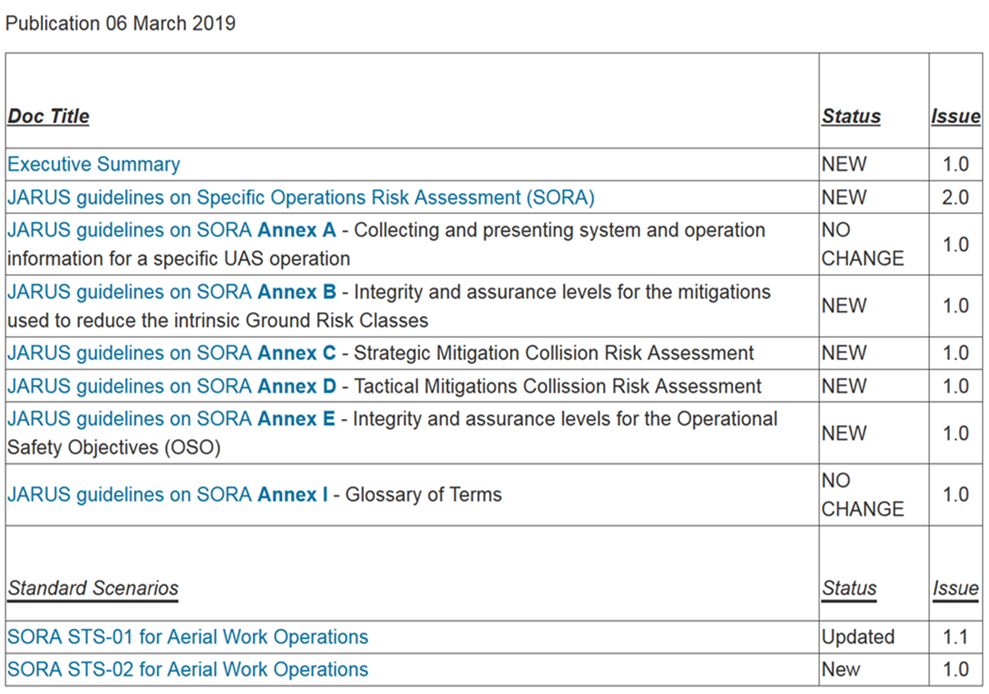
The primary purpose of the SORA analysis is to create a comprehensive safety portfolio, which is an attachment to the NAA application for permission to perform specific category flights. Therefore, before initiating the SORA procedure, the applicant (and the NAA - upon receipt of the application) should check that the proposed operation requires a SORA analysis, i.e. it is not subject to specific CA exemptions or a standard scenario.
The data to be verified before starting / SORA verification are:
• the operation is in the open category;
• the operation is covered by a standard scenario (STS) recognized by the competent authority;
• the operation is in the certified category;
• the operation is subject to a specific NO-GO issued by the competent authority;
• the competent authority has determined that the UAS is "harmless" to the risk on the ground.
A graphical presentation of the SORA semantic model is shown in Figure 3.
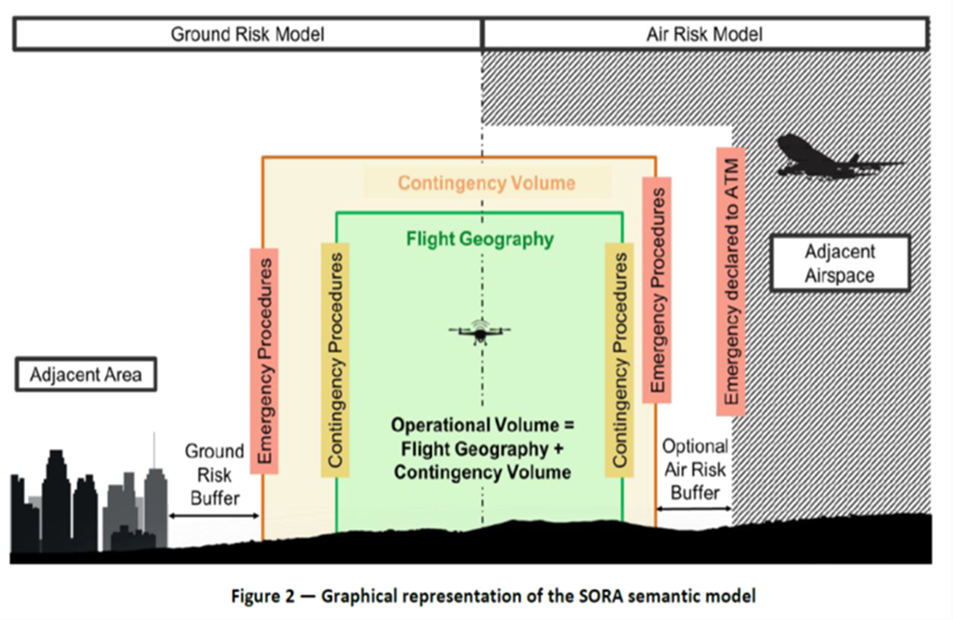
Fig. 3. Graphical presentation of the SORA semantic model
Source: JARUS Doc. 06 SORA - Specific Operations Risk Assessment (package), JAR-DEL-WG6-D. 04, 2019
The tabular equivalent of the SORA semantic model emphasizes the division of the course of operations into two states: operations under the control of the pilot and operations after the irreversible loss of control over it. Details are presented in Tab. 2.
Tab. 2. SORA - tabular presentation of the semantic model
Source: JARUS Doc. 06 SORA - Specific Operations Risk Assessment (package), JAR-DEL-WG6-D.04, 2019

The model assumes the determination of the hazard together with a suggestion of the applied general countermeasures in such a way as to obtain the limits of the safe execution of a specific UAS operation. SORA takes into account UAS of various classes and sizes as well as ground and air collision risks. SORA risk management runs from the concept of operations developed by the applicant through ten consecutive moves and sets the level of certainty of UAS operations adequate to the acceptable level of risk. The next ten steps are shown in Figure 4.

• fatal injuries of third parties on the ground;
• fatal injuries to third parties in the air;
• damage to critical infrastructure.
Many different categories of damage result from each event. The SORA document focuses on damage events (e.g. UAS disaster) that are short-term and may cause loss of health or life. Events with secondary, long-term effects (eg toxic emissions over time) are excluded from this assessment. The SORA recognizes that Competent Authorities, as appropriate, may consider additional categories of damage (e.g. social dissatisfaction, environmental damage, financial loss, etc.). This methodology can also be applied to these categories of damage.
2. Essential terms.
Hazard - according to the CAA Safety Management Manual, hazard means a situation or object with the potential to cause death or injury to a person, damage to equipment or structure, loss of material or reduce the ability of a person to perform certain functions.
Risk - in Annex 19 to the Chicago Convention, the risk is defined as the expected probability and severity of the consequences or effects of a hazard. Risk - the impact of uncertainty on the goals - ISO 31000: 2009 [10].
Robustness Concept, each risk reduction or operational safety objective can be demonstrated at different levels of robustness, which consists of two system components - integrity and certainty. SORA offers three different levels of robustness: low, medium, and high, proportionate to the risk. The determination of robustness is achieved by applying together the integrity level (i.e. safety gain, consistency of mitigation measures as a whole, the level of risk) provided by each constraint, and the level of assurance (i.e. a method of proof of the effectiveness of the measures used) stating that the claimed safety benefit has been achieved.
The actions used to justify the level of integrity are detailed in Annexes B, C, D, and E. These Annexes provide guidance or reference industry standards and practices, where applicable.
General guidelines for the level of assurance:
a. A low level of assurance is when the applicant simply states that the required level of integrity has been achieved.
b. The medium level of assurance is the one where the applicant provides evidence that the required level of integrity has been achieved. This is typically achieved by testing (e.g. to mitigate technical conditions) or evidence from experience (e.g. for mitigating human effects).
c. A high level of assurance is established when the competent third party has concluded that the integrity level has been achieved.
The dependence of the level of reliability on the level of integrity (safety gain) and the level of certainty is presented in Table 3.
Tab. 3. Dependence of the reliability level on the integrity level
Source: JARUS Doc. 06 SORA - SORA (package), JAR-DEL-WG6-D.04, 2019

The robustness will always be equal to the lowest level of either the integrity or the assurance.
3. SORA analysis procedure
Step #1 contains the description of the operation concept (ConOps description) - context.
It requires the applicant to collect and provide the relevant technical, operational, and system information necessary to assess the risks associated with the planned operation of the UAS. ConOps should be accurate and detailed. It can be an iterative process. It should also include information on how and when to interact with the air navigation service provider. Therefore, when defining ConOps, the UAS operator should pay due to attention to all steps, constraints, and objectives. Annex A of the SORA covers the preparation of ConOps in detail.
Step #2 - Determination of the intrinsic UAS Ground Risk Class
Intrinsic GRC is associated with the risk of hitting a person by the UAV (in case of losing control of the UAV with a rational assumption of the level of security). In order to establish the inherent GRC, the applicant needs data on the technical parameters of the UAS (e.g. wingspan for UAV (A), blade diameter for rotorcraft, maximum dimension for multirotor, etc.) and knowledge of the planned operation scenario. The applicant must identify the risk area when conducting the operation. The GRC value can be found in Table 4.
Tab. 4. Determination of the GRC ground risk class
Source: JARUS Doc. 06 SORA - SORA (package), JAR-DEL-WG6-D.04
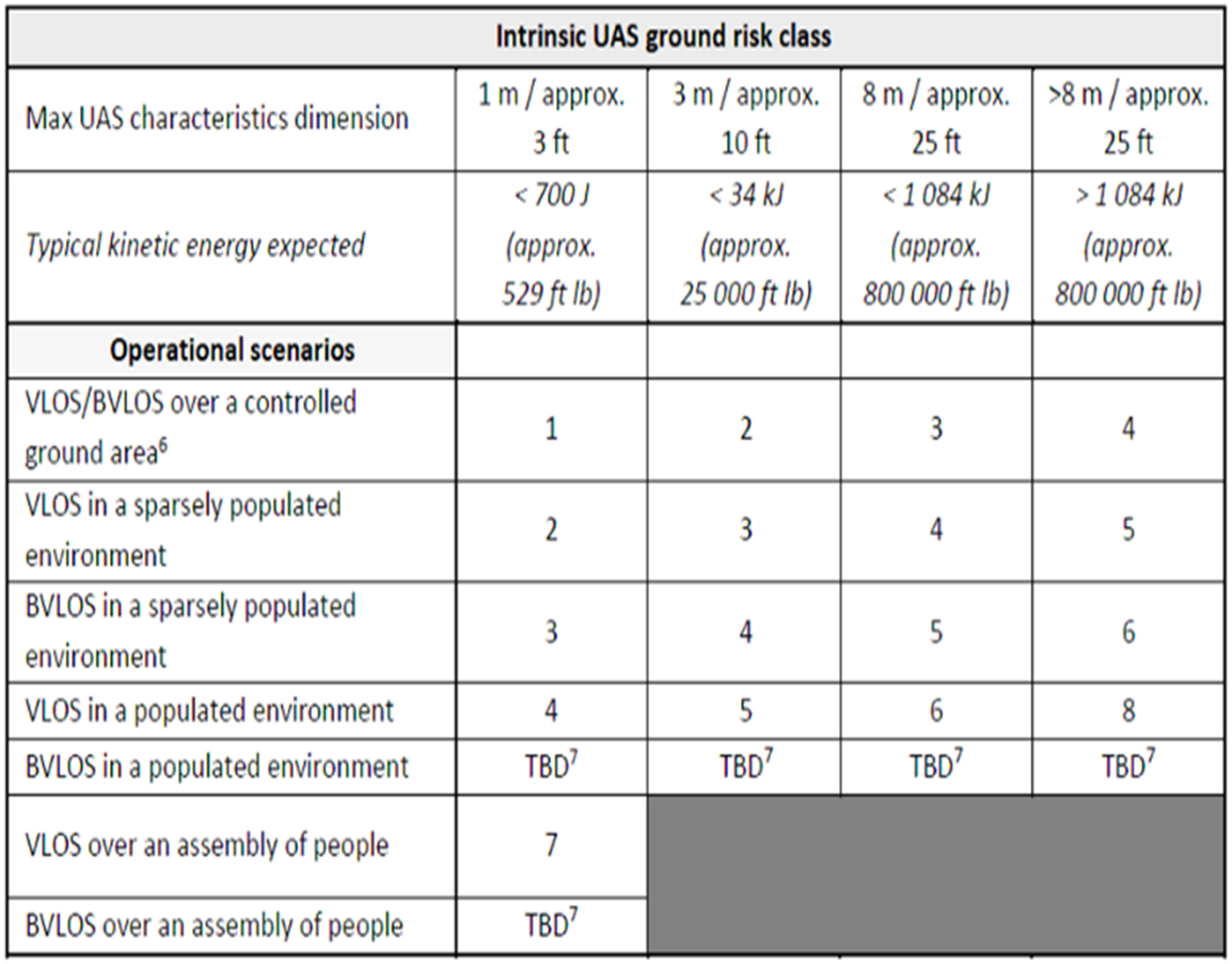
Step #3 - Final GRC determination, details Annex B.
The constraints applied to the intrinsic GRC modification have a direct impact on the security objectives of the operation, so it is important to ensure their robustness. This is of particular importance for technical countermeasures related to ground risks (e.g. rescue parachute). Step #3 marks the final GRC.
Annex B lists the types of risk mitigation measures used: M1, M2, and M3.
M1 - Strategic Mitigation of GRC Risk.
M1 restrictions are strategic mitigation measures to reduce the number of people at risk on the ground. To assess the levels of M1 mitigation integrity the following should be considered:
• definition of the ground buffer and its effects;
• assessment of the number of people at risk;
• specific criteria for the use of a tether.
M2 - Limiting the effects of hitting the ground
.
M2 mitigation measures are designed to reduce the effects of a ground impact following the loss of control of the operation. This is done by reducing the impact of UAV impact dynamics (i.e. surface, kinetic energy, velocity, etc.). One example of limitations is the use of a parachute.
M3 - Effective and introduced by the applicant ERP (Emergency Response Plan) in the event of loss of control over UAV.
The applicant should define the ERP in case of loss of control over the UAS. These are emergency / critical situations where it is impossible to regain control over the operation and the outcome of the situation largely depends on the case. If the ERP proposed by the applicant differs from the typical emergency procedures, the ERP is expected to include:
• plan to reduce the escalating effects of an accident (eg notify rescuers) and
• ATM notification method.
The levels of integrity and confidence criteria for mitigating risk are shown in Annex B
Step # 4 - Determination of the initial Air Risk Class.
The ARC is a qualitative indicator of the possibility that an unmanned aerial vehicle encounters a manned aircraft in a typical generalized civil airspace. The ARC is a pre-assignment of the aggregated risk of a collision in the airspace, prior to the application of mitigation measures.
ARC -a is generally defined as the airspace in which the risk of collision between UAVs and a manned aircraft is acceptable without adding any tactical limitation.
ARC-b, ARC-c, ARC-d generally define the airspace with the increasing risk of collision between UAVs and a manned aircraft. During UAV operations, the operating space may include many different airspace environments. From the diagram presented in Figure 5, the initial ARC airborne risk class can be determined.
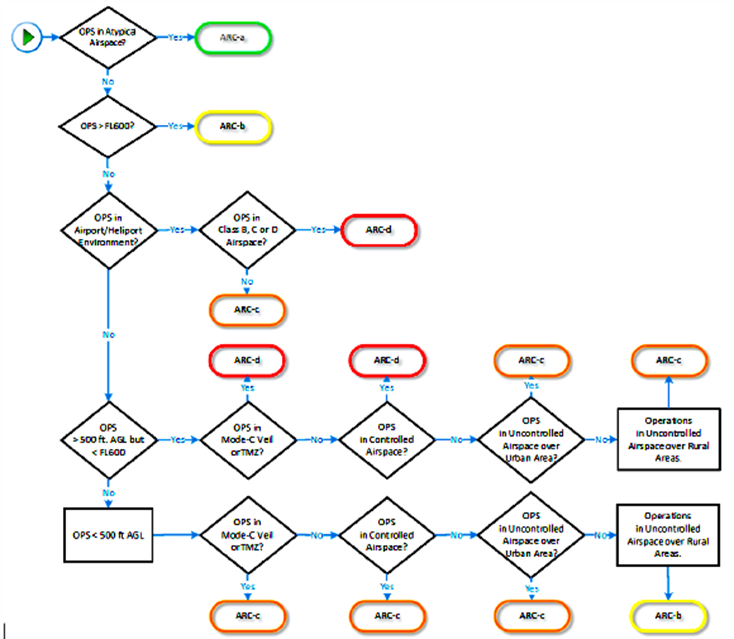
Fig. 5. Determining the ARC
Source: JARUS Doc. 06 SORA - Specific Operations Risk Assessment (package), JAR-DEL-WG6-D. 04, 2019
Step # 5 Application of Strategic Mitigations to determine Residual ARC - optional.
Risk mitigation activities are conducted when it is considered that the operating space may be associated with a risk of collision different from that assigned to the generalized initial ARC
If an applicant considers that the generalized initial assigned ARC is too high for the local operating volume condition, see Appendix C for information on the ARC reduction process and reduce the ARC using appropriate methods.
If the applicant believes that the generalized initial ARC assignment is correct for a state in the local operating space, then the ARC becomes a residual ARC.
Step #6 Tactical Mitigation Performance Requirement (TMPR) and Robustness Levels.
Step # 6 allows you to calculate a residual ARC.Tactical countermeasures are to mitigate any residual risk of airborne collision. This action is needed to meet the relevant airspace safety target. Tactical countermeasures take the form of "see and avoid" (under VLOS operations) or may require a system that provides alternative means of achieving an appropriate airspace safety target (DAA or multi-DAA operation). Appendix D describes methods for applying tactical mitigation measures.
There are two classifications of tactical countermeasures under SORA, namely:
a) a VLOS where the pilot and/or an observer uses human eyesight to detect an aircraft and takes measures to keep a safe distance from other aircraft and avoid collisions with them;
b) BVLOS, in which methods alternative to human perception, such as the use of devices or systems, allow to maintain a safe distance and avoid collisions with other aircraft (e.g. ATC, TCAS, DAA, Flarm, U-space, etc.).
The model of "Swiss cheese" by Professor Reason, cited earlier, presents in a graphic form the protective barriers preventing an accident. The Robustness of each of them reduces the level of the risk of airborne collisions in figure 6.
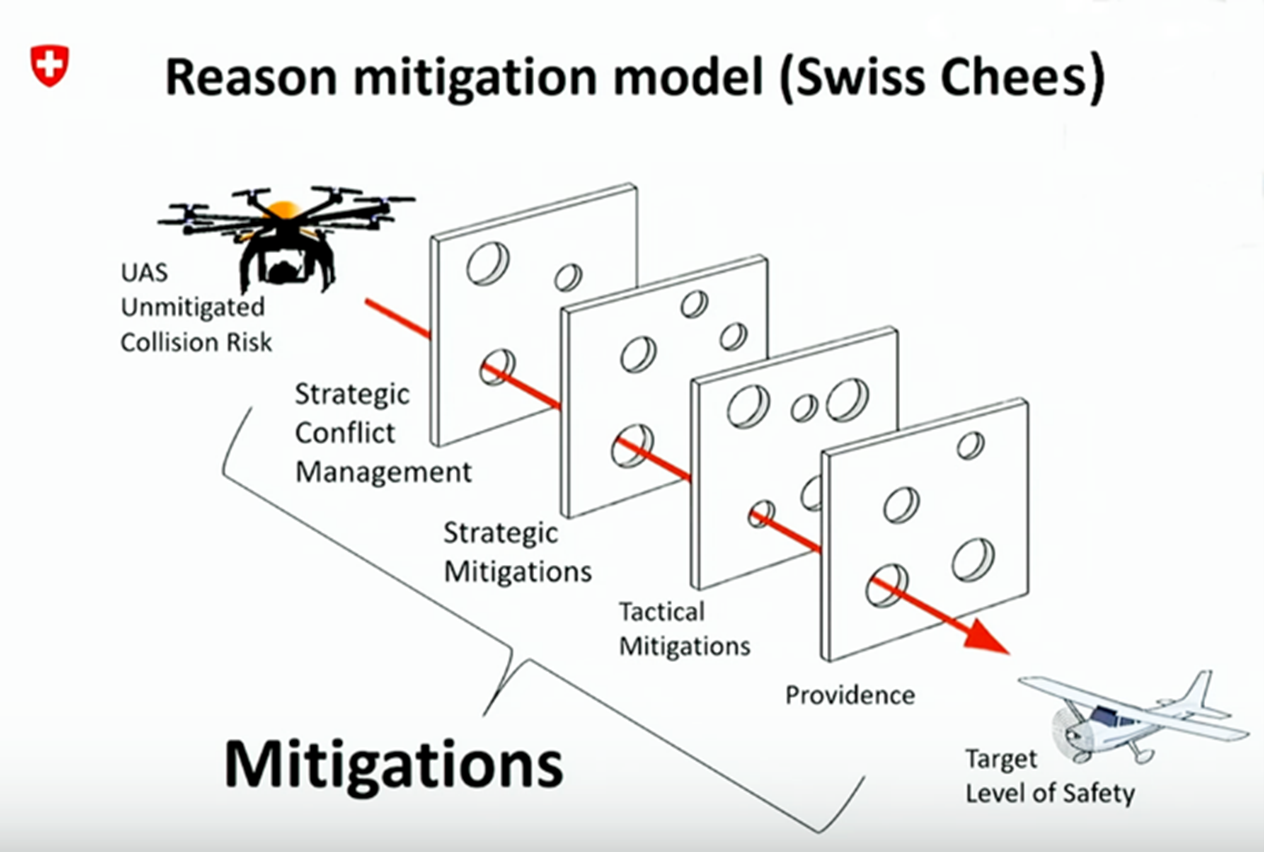
Fig. 6. Professor Reason's "Swiss cheese" model for UAS
Source: http://www.jarus-rpas.org/regulations
Step #7 Specific Assurance and Integrity Levels – SAIL
Once the final GRC and residual ARC are established, it is possible to obtain the SAIL associated with the proposed ConOps. The SAIL parameter consolidates the GRC ground and ARC ground hazards analysis and indicates the required actions. SAIL represents the level of confidence that the UAS operation will remain under control.
SAIL is not quantitative but refers to:
• Operational Safety Objectives (OSO);
• description of activities that can support compliance with these objectives;
• evidence that objectives have been achieved;
• The SAIL assigned to a specific ConOps is determined using table 5.
Tab. 5. Determining the SAIL value
Source: JARUS Doc. 06 SORA - SORA (package), JAR-DEL-WG6-D.04
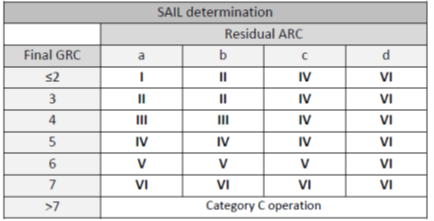
Step #8 - Identification of Operational Safety Objectives (OSO)
The goal of step #8 of the SORA process is to use SAIL to assess the effectiveness of risk reduction for operational safety (OSO) purposes and to determine the associated level of robustness. The OSO table represents the accumulated experience of many experts. Competent authorities may define additional OSOs for a given SAIL and its associated level of robustness. By knowing the SAIL value, the level of robustness can be determined for each OSO. Robustness has four levels:
O is optional,
L is recommended with low robustness,
M is recommended with medium robustness, and
H is recommended with high robustness.
24 OSOs were divided into 4 groups of issues. The groups and their content are summarized in Table 6.
Tab. 6. Recommended OSOs
Source: JARUS Doc. 06 SORA - SORA (package), JAR-DEL-WG6-D.04

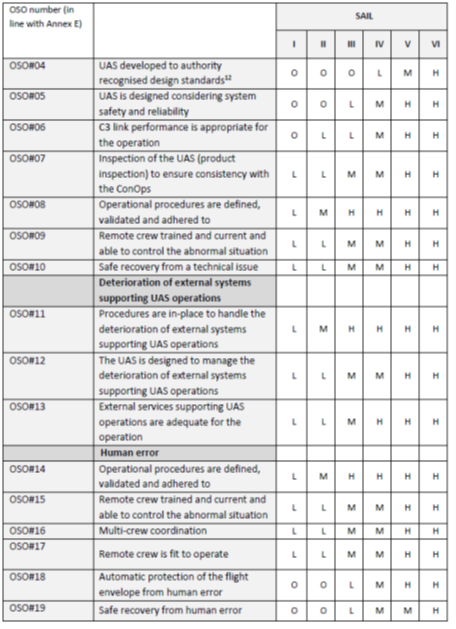
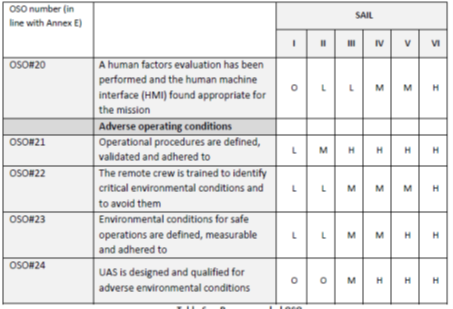
SORA in step #8 lists the SAIL-dependent OSO robustness level. For each OSO from the table, the robustness level (O, L, M, H) is determined which corresponds to the specified SAIL value (from I to VI).
An example of determining the robustness level is presented in Table 7, which is part of the compilation for all OSOs.
Tab. 7. Determination of the SAIL. Value robustness level concerning the SAIL
index for specific operational safety objectives (OSO)
Source: part of the table based on JARUS Doc. 06 SORA - SORA (package), JAR-DEL-WG6-D.04
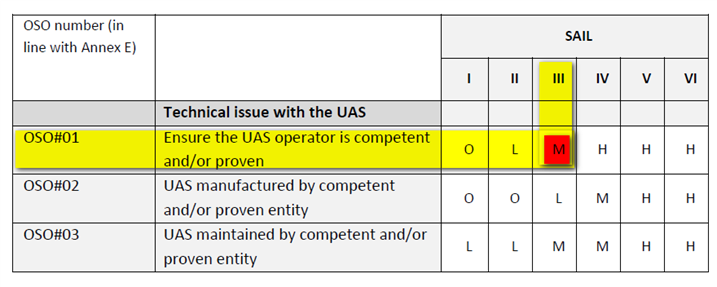
For the exemplary SAIL III and OSO # 01, the robustness index for a given operation assessed was designated as M (medium).
Annex E Integrity and assurance levels for the Operation Safety Objectives provide information on the criteria that must be met to obtain approval for the planned operation. The level of robustness for a given OSO (in Annex E) corresponds to certain criteria necessary to perform the operation at an acceptable risk level. The criteria relate to levels of integrity and levels of assurance. The necessary condition is that all criteria indicated for a given OSO are met. Table 8 lists the criteria for OSO #01 and the robustness M (medium) index determined for it, for example.
Tab. 8. Criteria required for step # 01 (example)
Source: on the basis of Annex E, JARUS Doc. 06 SORA - SORA (package), JAR-DEL-WG6-D.04
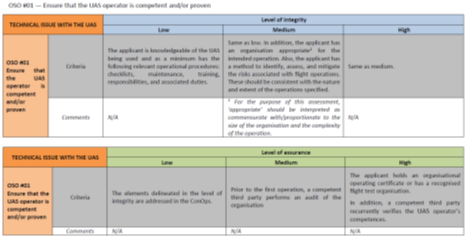
Step #9 - Adjacent Area / Airspace Consideration issues
The goal of step #9 is to address the risk of losing control of an operation resulting in the violation of adjacent areas on the ground and/or adjacent airspace. These areas may vary depending on the different phases of flight.
Step #10 - Comprehensive Safety Portfolio
In step # 10, the applicant prepares a safety portfolio on the SORA performed and presents to the competent authority and the ANSP a methodology that includes some mitigation measures and safety objectives that need to be considered to provide an adequate level of confidence that the operation can be safely performed. These are:
• Countermeasures used to mitigate internal GRC
• Strategic mitigation actions for the initial ARC
• Tactical mitigation measures for residual ARC
• Adjacent area/airspace considerations
• Operational security objectives
4. Evaluation of the method.
SORA as a method can be widely used as early as 2021. EASA in the document Acceptable Means of Compliance (AMC) and Guidance Material (GM) to Commission Implementing Regulation (EU) 2019/947, 9 October 2019 prefers this method as the leading one, although it does not exclude the possibility of using other methods. The safety portfolio described in step #10 of the SORA is part of the application to the aviation authority for permission to perform specific category flights. Worth underlining that the aviation authority may accept the use of other methods of risk analysis in order to demonstrate risk reduced to a safe level.
The method is extensive and has many features and elements that were taken into account when evaluating it. It is a framework assessment, a general one due to the lack of experience with its application. A set of criteria was adopted for evaluation, which were divided into two groups: basic and additional criteria.The basic criteria include the primary risk management factors of hazards: identification of the sources of hazards and hazards, the effects of materialization of hazards, risk analysis on the ground and in the air, risk evaluation and mitigation, a total of seven criteria. The second group of criteria includes additional factors related to the scope, functionality and application of the method, including 11 criteria. The SORA method was rated high, medium and low according to the established criteria. When evaluating the method, the total weight of the core criteria was found to correspond to the total weight of the additional criteria. This is due to the superiority of the basic criteria over the additional criteria. Therefore, for the basic criteria for high, medium and low scores, respectively 3, 2 and 1 points were assumed, and for additional criteria for 2, 1 and 0.5 points. The evaluation results are summarized in Table 8.
Tab. 9. Tabulated summary of the SORA assessment
Source: own study
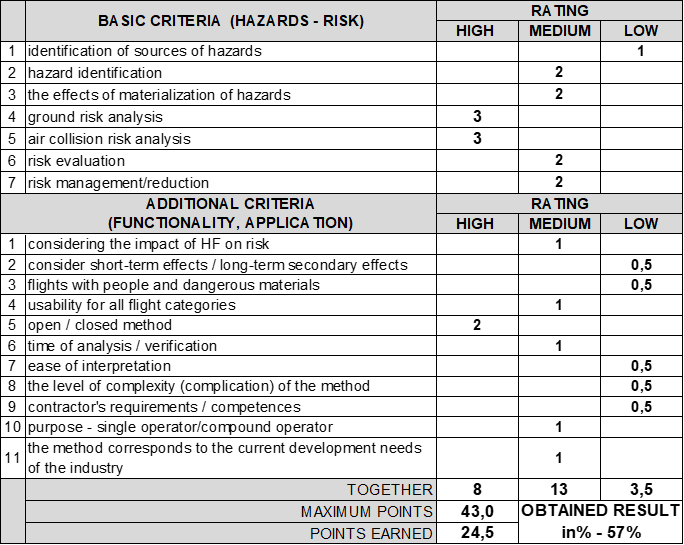
The rationale for the assessment of the basic criteria is as follows:
• The risk analysis for flights in the SORA specific category discusses the GRC ground risk and ARC airborne collision risk profoundly and therefore the rating for these criteria is high.
• Materialization of hazards is limited to three basic consequences: loss of health and life of people and damage to critical infrastructure. Material effects such as the operator's own losses or various types of intangible losses were ignored, hence the assessment of the medium was given.
•The identification of GRC and ARC hazards and the evaluation of the risk are carried out in the next steps # 2 - # 6 and its management and methods for reducing it are included in Annexes B, C, and D. The procedure is complex and detailed. For these reasons, these criteria were rated medium.
• SORA is very little concerned with identifying sources of hazards, hence the evaluation of this criterion is low.
The rationale for the assessment for the additional criteria is as follows:
• A high score was given to the criterion of openness of the method, which is not a closed system, but can be modified according to the NAA needs or changing conditions.
The additional criteria listed below were assessed at the medium level:
• The impact of the human factor on the level of risk has been satisfactorily addressed in step # 1 in the description of the operation concept, Annex A, part 1, and in step # 6 and the TMPR-related Annex C. The remaining parts of the SORA procedure do not take into account the significant impact of HF on the safety level.
• Usability for all flight categories is contractual and not real. SORA can be used not only for a dedicated category of specific flights. However, in many cases, the concept of operation determines the qualification of a flight to an STS or certified category without the need to use SORA.
• The analysis/verification time is not short due to the large number of details contained in Annexes A, B, C, D, and E.
• The use of the SORA method by single-person operators is formally accepted. Due to the complexity of the method, the use of SORA by small operators is difficult to implement.
• The SORA method will be operational from the beginning of 2021. Due to the conservative nature and not always justified overstating the requirements for risk reduction, SORA does not fully meet the contemporary demand in this area.
The additional criteria listed below have been assessed as low:
• SORA is limited to taking into account direct, short-term effects and not secondary or long-term effects.
• SORA does not take into account the hazards and risks associated with the transport of people and dangerous materials.
• Due to the high degree of processing of the concepts of hazard and risk into numbers and levels of robustness, the obtained results are not easy to interpret and intuitively perceive.
• The high degree of complexity and a great amount of detail makes the method very difficult to apply.
• The requirements and competencies necessary to conduct the SORA analysis must be high enough to ensure the correct performance of the analysis, which limits the scope of its use.
The obtained assessment of the SORA method leads to the following conclusions. The result of 57% allows to state that SORA is not currently a method properly adjusted to the realities of using unmanned systems. Due to the maintenance of public confidence in the safety of air transport, a conservative method was constructed, intended for the UAS, but clearly influenced by restrictive and radical methods used in manned aviation (see Figures 1 and 2). There are doubts as to whether the SORA method is not a kind of over-regulation in safety matters concerning the current level of development of the UAS industry. Do the features of the SORA method result from insufficient adjustment of the regulation to the current market needs? National and European statistics on the insignificant number of accidents involving UAS confirm the above assumptions. Despite the scale with which the SORA was designed and its advantages, it has many limitations, e.g. it cannot be used for flights with people or dangerous materials on board. One can get the impression that EASA's recommendation of the SORA analysis is not entirely consistent with other activities. EASA simultaneously introduces regulations that eliminate SORA from wide use. The SORA method will not be needed for open, certified, STS, or LUC-certified flights. With the standardization of UAS flight conditions and procedures and the possibility of creating NSTSs by the national aviation authorities of EU members, the SORA method may be used sporadically over time.
The SORA method has not been evaluated so far. There are no unequivocal opinions about the high usefulness of the SORA method in world literature. AW DRONES [16] published the results of the survey on EUROPEAN OPERATIONS AND OPERATIONAL RISK ASSESSMENT METHODS, a total number of respondents 247 from 22 countries, date of issue: 201013. The summary includes statements clearly confirming the assessment presented above. Selected fragments of AW DRONES conclusions (quotes):
• ”The SORA guidelines are currently only used by a relatively small minority of the European drone operators”.
• „The use of risk assessment methods other than SORA (e.g. nationally approved processes, national standard scenarios, predefined risk assessment) currently has the preference of the majority of the drone operators”.
• „The very low amount of (pre-qualified) respondents (8% of the total) clearly indicates that SORA is not widely understood & used”.
• „National Standard Scenarios (STS) and Predefined Risk Assessment (PDRA) and ‘‘other means’’ seem to be the preferred operation safety risk assessment methods”.
BIBLIOGRAPHY
5M model, https://en.wikipedia.org/wiki/5M_model.
Central Reports Database (CBZ), https://cbz.gov.pl/
Civil Aviation Authority, Drone Safety Risk: An assessment, Aviation House, Gatwick Airport South, West Sussex, RH6 0YR, CAP 1627, 2018.
COMMISSION IMPLEMENTING REGULATION (EU) 2019/947 on the rules and procedures for the operation of unmanned aircraft, of 24 May 2019.
Drone Industry Insights, Safety Risk Assessment for UAV Operation, Safe Airspace Integration Project, Part One, Nov. 2015.
FAA, Safety Management System Manual, Air Traffic Organization, April 2019.
HAWKINS FRANK H., Human factors in flight, Aldershot, England, Avebury Technical, 1993.
ICAO Circular 240-AN/144, Human Factors Digest No. 7, Investigation of Human Factors in Accidents and Incidents, 1993.
ICAO Doc 10019, Manual on Remotely Piloted Aircraft Systems (RPAS), 2015 (good glossary and definitions).
ISO 31000:2009 Risk Management – Principles and Guidelines.
JARUS Doc. 06 SORA - Specific Operations Risk Assessment (package), JAR-DEL-WG6-D.04, 2019.
Lawrence C. Barr i inni, Preliminary Risk Assessment for Small Unmanned Aircraft, 17th AIAA Aviation Technology, Integration, and Operations Conference 5-9 June 2017, Denver, Colorado.
Methodology for the Specific Operations Risk Assessment (SORA) by JARUS - UAS Workshop 2018.
PansaUTM https://www.pansa.pl/pansautm/
ALAN, Stolzer J., JOSEPH, Goglia John, Safety management systems in aviation, London: Routledge; Taylor and Francis Group, 2016.
SURVEY ON EUROPEAN UAS OPERATIONS & OPERATION RISK ASSESSMENT METHODS – CONCLUSIONS, AW Drones, Issue Date: 201013, https://rps-info.com/uas-ops-and-ops-risk-surveys-results-and-conclusions/
Recibido el 10 de abril de 2020. Aceptado el 30 de mayo de 2023
Nota bene:
Si necesita algún tipo de información referente al artículo póngase en contacto con el email suministrado por el autor del artículo al principio del mismo.
REVISTA EUROPEA DE LA NAVEGACIÓN MARÍTIMA Y AERONÁUTICA es una revista académica,
editada y mantenida por Revistasdederecho.com. La revista dejó de depender de la Universidad de Málaga en noviembre de 2013 y de www.eumed.com en noviembre de 2020, fecha en
la que se conformó www.revistasdederecho.com. Para cualquier comunicación, envíe un mensaje a mjpelaez@uma.es, seghiri@uma.es o info@revistasdederecho.com.

Fig. 1. Comparison of TLS for airborne risk
Source: Methodology for the Specific Ops Risk Assessment (SORA) by JARUS - UAS Workshop 2018

Fig. 1. Fig. 2 Comparison of TLS for risk on the ground
Source: Methodology for the Specific Ops Risk Assessment (SORA) by JARUS - UAS Workshop 2018


Fig. 3. Graphical presentation of the SORA semantic model
Source: JARUS Doc. 06 SORA - Specific Operations Risk Assessment (package), JAR-DEL-WG6-D. 04, 2019





Fig. 5. Determining the ARC
Source: JARUS Doc. 06 SORA - Specific Operations Risk Assessment (package), JAR-DEL-WG6-D. 04, 2019

Fig. 6. Professor Reason's "Swiss cheese" model for UAS
Source: http://www.jarus-rpas.org/regulations







